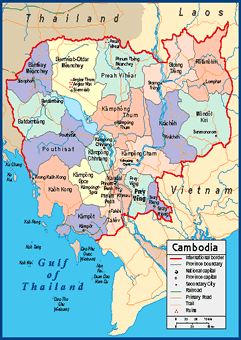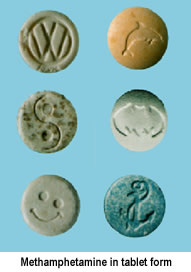
U.S. Drug Enforcement
Administration
www.dea.gov
 |
U.S. Drug Enforcement
Administration |
 STATUS IN INTERNATIONAL DRUG TRAFFICKING
STATUS IN INTERNATIONAL DRUG TRAFFICKING
Cambodia is a source country for marijuana destined for Europe. Cambodia is
also a transit country for Southeast Asian heroin destined for international
drug markets. Drug-related money laundering in the banking and investment
communities is becoming an increasing concern for the Cambodian Government and
the international community.
CULTIVATION AND
PROCESSING
Marijuana is cultivated throughout Cambodia, but most of the marijuana that is grown for export is grown in Kaôh Kong, Batdambâng, Kâmpông Spœ, Krâchéh, Kandal, Kâmpông Cham, and Kâmpôt Provinces. There are no estimates available from either the Cambodian Government or the United Nations Drug Control Program (UNDCP) on the current extent of marijuana cultivation or yield. Marijuana cultivation is often done by hand using traditional farming methods. The normal harvest period for Cambodian marijuana is in the period of late December and early January. The Cambodian Government claims to have eradicated at least 80 hectares of marijuana fields in Kâmpôt and Kâmpông Cham Provinces in early 2000.
While the growing of marijuana plants has been illegal in Cambodia since 1996, tons of Cambodian marijuana continue to be seized around the world each year. Estimates of Cambodian marijuana production range between 700 and 1,000 tons annually. Most marijuana is exported after it is dried and packaged. The Cambodian Government is currently working with UNDCP to fund crop substitution and marijuana eradication programs to stem the flow of marijuana from Cambodia.
TRAFFICKING
 Marijuana
Marijuana
Most marijuana leaving Cambodia makes its way into international drug markets from ports along the southern coastline of Cambodia. The remainder of the marijuana leaves Cambodia by land-route through Vietnam for entry into international drug markets.
On April 24, 2001, the Hong Kong Police/Narcotics Bureau had their largest marijuana seizure in history. Approximately 1.95 metric tons of marijuana from Cambodia were seized and three traffickers were arrested. The shipment of Cambodian marijuana was seized while being unloaded from a fishing vessel onto a truck. The eventual destination points for this marijuana were Hong Kong, Macau, and some locations in Southern China.
 Heroin
Heroin
Southeast Asian heroin enters Cambodia from Laos and Thailand. The heroin
entering from Laos can be of either Laotian or Burmese origin. This heroin
enters Cambodia by boat on the Mekong River into Sœng Trêng Province. The heroin
entering from Thailand is usually of Burmese origin and crosses a border that is
hundreds of miles of rugged, unpatrolled terrain. Regardless of the type of
heroin, it is subsequently transported to Phnom Penh for sale or international
transshipment. Some of the heroin, in kilogram quantities, is shipped to Vietnam
for distribution. The shipments to Vietnam are either by boat on the Mekong
River or by road through established border crossings.
DRUG-RELATED MONEY LAUNDERING
Cambodia is not a major financial center, and only a few of the 30 banks operating in Cambodia have a significant volume of international business. However, a significant portion of Cambodia’s economy conducts business transactions in U.S. dollars, and customs controls over the import and export of currency is weak, as is regulation of the banking sector. Consequently, there may be significant, unregulated, and unreported informal flows of currency in and out of Cambodia. Casinos are both legal and very active, and are being used for laundering large amounts of money.
The banking laws in Cambodia are very weak. The entire banking sector is in need of restructuring to be effective against money laundering. The weaknesses in the Cambodian banking system make it very easy to use standard wire transfers to launder money. Also, there are no regulations to prevent or place accountability on large cash deposits, which facilitates the concealing of illicit funds. The Government of Cambodia recognizes some of these weaknesses in its banking system and is interested in cooperating with foreign law enforcement agencies to take action against major money launderers.
DRUG ABUSE AND TREATMENT
 Drugs of Choice
Drugs of Choice
For many years, Cambodia was the only Southeast Asian country without a significant drug abuse problem. Over the past few years, however, methamphetamine has been the drug of choice for fashionable, wealthy, young adults making their rounds on the nightclub scene. During 2000, there was a significant rise in methamphetamine use throughout Cambodian society, from rice farmers to students. Marijuana is used throughout Cambodia. Other drugs that are abused to a much lesser extent are various pharmaceuticals, opium, and heroin.
Addict Population
There are currently no estimates available on the number of Cambodian drug
addicts. The Government of Cambodia is currently setting up the programs to
collect, analyze, and publish this information in the next few years.
Treatment and Demand Reduction Programs
The National Authority for Combating Drugs and the Ministry for Health are to begin collaboration on establishing treatment and rehabilitation centers as well as vocational training centers for recovering drug addicts. The Government of Cambodia has established Provincial Drug Control Committees in each of the 24 provinces throughout the country to collect data on drug activities, the extent of trafficking, and the numbers of drug addicts. The reports from these committees will be used to improve law enforcement, target drug education programs, and direct future drug treatment programs.
DRUG LAW ENFORCEMENT AGENCIES AND LEGISLATION
Cambodia’s national police system is under the Ministry of the Interior. The Government of Cambodia established the National Authority for Combating Drugs (NACD) to consolidate its drug control policy and created the National Anti-Drug Unit (NADU) as a special enforcement unit within the National Police. The NACD works closely with the NADU and various regional and international drug law enforcement agencies.
The effectiveness of the NACD and the NADU is greatly limited because of a lack of training and resources, and the country’s location adjacent to a major drug production area. Few officers have ever received any kind of formal drug law enforcement training. Most of the lower ranking police officers only have an elementary school-level education.
During 2001, the Drug Enforcement Administration Bangkok Country Office provided training for 60 Cambodian police officers in various intelligence and enforcement techniques. The Bangkok Country Office plans to continue the yearly training courses for Cambodian police officers in addition to the training that is being offered by the UNDCP.
TREATIES AND CONVENTIONS
Cambodia is not a party to the 1988 U.N. Drug Convention, the 1961 U.N.
Single Convention as amended by the 1972 Protocol, or the 1971 U.N. Convention
on Psychotropic Substances. However, Cambodia has passed legislation bringing it
into compliance with the conventions, while not becoming a party to the
conventions. Cambodia currently has no mutual legal assistance treaty or
extradition treaty with the United States. However, the Government of Cambodia
has been willing to detain and expel foreign fugitives, and continues to
cooperate to reduce drug trafficking within its borders.
STATISTICAL DATA
Arrests
In 2000, there were 124 people arrested on drug offenses. Of the 124 people arrested, 81 were foreign nationals.
Seizures
In 2000, the NADU seized 1,108 kilograms of cannabis products.
KEY JUDGMENTS
• Cambodia will probably continue to be a transit country for Southeast Asian heroin out of Laos and Burma (through Laos and Thailand) that is destined for markets worldwide.
• Cambodia continues to be a producer of large amounts of marijuana for both domestic use and for shipment to Europe and throughout Southeast Asia.
| This report was prepared by the DEA Intelligence Division, Office of Domestic Intelligence, Domestic Strategic Unit. Comments and requests for copies are welcome and may be directed to the Intelligence Production Unit, Intelligence Division, DEA Headquarters, at (202) 307-8726. |
DEA-01026